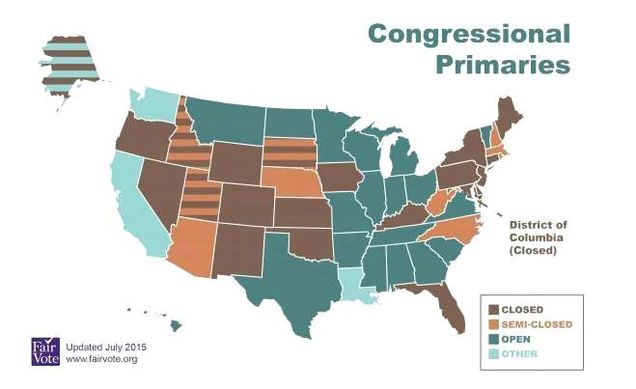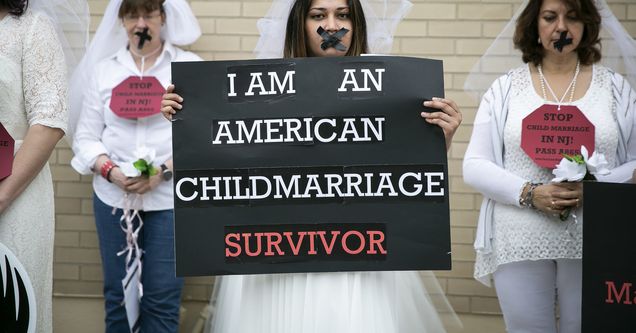Blanket Primaries or Ranked-Choice? Why Not Both?
A substantial number of Americans continue to voice dissatisfaction with current American electoral practices. This has put Justice Brandeis’s laboratories of democracy to work by prompting some states to exercise their powers to design election systems to experiment with various electoral reforms. Those powers derive from the state constitutions for elections of state officers; Article I, Section 4 of the U.S. Constitution to “[prescribe] the Manner of holding Elections for Senators and Representatives”, and the U.S. Constitution Article II, Section 1 to determine how electors for President may be chosen.
Many states have allowed their municipalities to experiment, with a few states adopting reforms on a state-wide level. In the latter category, some states, like California and Washington, have adopted what is sometimes described as the top-two, blanket, or Louisiana primary, while Maine has implemented ranked-choice voting. While these reforms have been innovative, study of their effects reveals limited success in achieving advocates’ promises. This post concludes that by combining both reforms, states will be better positioned to access the positive outcomes hoped for.
Blanket Primaries
Former Republican congressman from Oklahoma, Mickey Edwards, has argued that the problem with American politics is our  broken election system that rewards partisanship at the expense of good policy. Edwards argues that the culprit is the primary. Primary election turnout is notoriously low, with a recent Pew Research Center study celebrating a surge in participation in the 2018 House primary elections of 56% – a surge that still left turnout in that primary under 20%. The belief is that since political participation in primaries is so low, they are dominated by the most active, and most partisan, members of the parties, limiting the success of more centrist candidates, who are presumably more representative of their districts. In particularly politically active years, incumbents are at risk of being “primaried” by extremists in their party. Thus, the candidates in the general election tend to be more extreme, on both ends, than the district, and the eventual winner is then likely to represent only one extreme, rather than the district as a whole.
broken election system that rewards partisanship at the expense of good policy. Edwards argues that the culprit is the primary. Primary election turnout is notoriously low, with a recent Pew Research Center study celebrating a surge in participation in the 2018 House primary elections of 56% – a surge that still left turnout in that primary under 20%. The belief is that since political participation in primaries is so low, they are dominated by the most active, and most partisan, members of the parties, limiting the success of more centrist candidates, who are presumably more representative of their districts. In particularly politically active years, incumbents are at risk of being “primaried” by extremists in their party. Thus, the candidates in the general election tend to be more extreme, on both ends, than the district, and the eventual winner is then likely to represent only one extreme, rather than the district as a whole.
To address this concern, Edwards advocates for a reform known as “blanket” primaries, sometimes referred to as “Louisiana,” “jungle,” or, most accurately, “top two” primaries. This reform provides that in the primary election, there is a single ballot, with all candidates on the ballot regardless of party. The top-two candidates who receive the most votes then move on to the general election. This means that the candidates in the general election may both be from the same party, particularly in districts whose residents heavily identify with one party over the other. This may make for more competitive general elections, in that a candidate who is almost certain not to win isn’t on the ballot, in favor of a candidate who actually has a chance of convincing voters to vote for them. Also, along with Edwards’s hope that this will reduce partisanship by ensuring the candidates in the general election better represent the center of the district, advocates have also claimed that it will increase turnout.
Unfortunately, the data provides only marginal support for the proposition that blanket primaries reduce partisanship and increase turnout. An added challenge to blanket primaries is that because only the top-two move on, it is subject to vote splitting – if too many candidates from a party enter the race, they may end up without any candidates in the general simply by virtue of the number of candidates in the race, rather than voter preferences. Thus, blanket primaries are not a panacea, at least on their own, for electing more representative representatives.
Ranked-Choice Voting
Maine has moved in a different direction, adopting ranked-choice voting (“RCV”), a darling of electoral reform advocates for decades. RCV has a long pedigree, first having been promoted publicly in the United States by William Robert Ware in the 1870s. Some states and municipalities flirted with a version of RCV, known as single transferable vote, in the last great shift in party power during the early- to mid-twentieth century. RCV and similar systems have also been successfully used internationally – including in Australia, and Ireland.
While there are many different iterations of ranked-choice voting, Maine has adopted the most typical approach. There, voters may rank candidates first, second, third, and so on. If a candidate gets a majority of first-rank votes, they are declared the winner. However, if no candidate receives a majority of votes, then the candidate with the least number of votes is eliminated, and the voters who ranked that candidate first have their votes redistributed to their second-rank candidates. If no candidate has a majority, the new candidate with the lowest number of votes is eliminated, and their voters’ ballots are also redistributed. The system continues until a candidate has secured a majority of preferences.
Advocates of ranked-choice have also claimed that the system reduces partisanship, since candidates are encouraged to appeal to voters to rank them second, even if they can’t secure their first preference. Advocates also argue that it increases turnout by
making the ballot more reflective of voters’ wishes. As with blanket primaries, however, there is only modest statistical data showing that the turnout hopes are borne out.
A Proposal
States should consider merging the two systems, blanket primaries and RCV, in order to best access the benefits of each. The real problem that neither system effectively can address is the issue of turnout. Primary elections typically draw the most politically aware sector of the electorate that is most invested in who the candidates in the general election are, but turnout remains exceedingly low regardless of the system. Blanket primaries attempt to appeal to an electorate disenchanted by the current partisan model and looking to elect “the best candidate,” but since they continue to rely on a two-stage electoral model, they don’t resolve the fundamental problem. The most partisan members of the electorate participate in the blanket primary, and turnout surges, as it always does, in the general, after the partisans have already selected who will be on the ticket. Combining ranked-choice with the blanket primary would allow there to be a single election, ensuring the highest number of voters considering all the available candidates, not just those the partisans have already selected. Moving to a single election, with candidates on a single ballot regardless of party, and using RCV would ensure that the larger electorate would be able to weigh-in, allow them to rank their preferences, and ensure that the candidate who emerged was the preferred candidate of a majority of voters. This will increase elected officials’ mandate, and provide more information about what direction the district would like to go in.
Slowing Chipping Away at Child Marriage in the US
Child marriage is condemned by the international community and the stated goals of the U.S. State Department. In fact, the State Department’s “U.S Global Strategy to Empower Adolescent Girls” calls marriage before 18 a “human rights abuse.” However, most states still have laws that allow for the marriage of children under the age of 18. Eighteen states don’t even have a minimum age that a child can be married. So far in the US, only two states, New Jersey and Delaware, have banned all child marriages with no exceptions. Between 2016 and 2018, eleven states have passed laws that limit child marriage but still keep some exceptions, mainly relating to parental consent and 16 or 17-year-olds marrying someone within a few years of their own age. Ten additional states have introduced bills curtailing child marriage, many of which were sent to study or died at the end of the legislative session in 2018, but with plans to be reintroduced in the next session.
The advocacy organizations leading the charge for new protections for minors are insistent that only a limit of 18 years old with no exceptions is good enough; especially since some of the legal exceptions exacerbate the problem. For example, requiring only parental consent, especially when only a single parent’s consent is needed for marriage under the age of 18 leaves minors unprotected from marriage due to coercion. A few states still allow for exceptions when the girl is pregnant, even if she is below the age of consent. Pregnancy, of course, is one of the situations where girls are most often coerced into marrying men, some of whom are their rapists.
Earlier this month, Ohio joined the ranks of states attempting to fix this problem, if imperfectly. House Bill 511 was introduced by
Republican Rep. Laura Lanese and Democratic Rep. John Rogers last year with the intention of updating the former law, which treated boys and girls differently. Previously, girls could get married at 16 with parental consent, although boys could not get married below the age of 18 without the consent of a juvenile court.
The new law, which was signed by Governor John Kasich just before he left office in January, creates gender equality by requiring both boys and girls to be 18 in order to get married. The only exemption allowed is a marriage at 17 if there is no more than a four-year age difference, if a juvenile court consents and requires a 14 day waiting period. In the processes of determining whether to give consent, the court is instructed to consult with the parent or guardian, and appoint a guardian ad litem. Additionally, a court must determine if the minor is in the armed forces, employed and self-subsisting or otherwise independent of a parent or guardian, and if the minor is free from force or coercion in the decision to marry. The couple must also have completed marriage counseling satisfactory to the court. Additionally, a provision was added that requires official proof of age.
 There were strong reasons for the Ohio Legislature to act. According to the Dayton Daily News, over 4,400 girls aged 17 or younger were married in Ohio between 2000 and 2015. Of those, 59 were 15 or younger, and three were 14 years old. Additionally, according to the Ohio Department of Health, there were 302 boys under the age of 17 were married between 2000 and 2015, with the approval of parents or a juvenile court. A significant driver of the child marriages seems to be when a minor girl gets pregnant by an older man.
There were strong reasons for the Ohio Legislature to act. According to the Dayton Daily News, over 4,400 girls aged 17 or younger were married in Ohio between 2000 and 2015. Of those, 59 were 15 or younger, and three were 14 years old. Additionally, according to the Ohio Department of Health, there were 302 boys under the age of 17 were married between 2000 and 2015, with the approval of parents or a juvenile court. A significant driver of the child marriages seems to be when a minor girl gets pregnant by an older man.
These types of marriages have harsh consequences including being 50% more likely to drop out of high school, three times more likely to experience psychiatric disorders, and divorce rates of almost 80%, which can more than double the chance a teen mother ends up in poverty. Additionally, women who marry as minors lack the ability and resources to remove themselves from a harmful relationship. For example, most domestic-violence shelters cannot accept minors, minors who leave home are considered runaways, and child-protective services can usually do little in regards to legal marriages. Furthermore, a child is unlikely to have the resources to escape an abusive relationship, pay attorney fees, or even sign any other legally binding document.
In Massachusetts, there is currently no age requirement for marriage, with minors requiring a half page petition, and approval by parents and the courts. The statistics for child marriages in Massachusetts consist of 1,200 children as young as 14 married from 2000 to 2016. In the time period from 2005 to 2016, 89% were underage females married to adult men. In 2018, Democratic Sen. Harriet Chandler and Democratic Rep. Kay Khan introduced bills (S785/H2310) to end all child marriage with no exceptions. The bill stalled, however, because as Democratic Rep. Khan noted because legislators were not been able to hear from victims who want to talk about their experience. The bill was refiled at the beginning of the new legislative session that began in January.
Slowly, but surely, states are addressing the evils that come with child marriage.
 Amanda Simile will graduate from Boston University School of Law in May 2020.
Amanda Simile will graduate from Boston University School of Law in May 2020.
Stop the Clock: Implications of Switching Time Zones
The holiday season is joyous for many reasons; from family, friends, and food, there is ample joy and merriment to go around. There is one aspect of the season that doesn’t match these factors; especially in New England – darkness. At the outset of winter, on December 21st each year, the sun sets in Boston at 4:11pm. There are many negative effects of darkness setting in before the end of the workday – with increased crime, traffic accidents, and seasonal depression being one of the most paramount. Boston’s sunset is not the earliest in the area, with municipalities in Maine experiencing sunsets earlier than 4pm; but it is the earliest of the major cities, beating out Buffalo, NY despite being further south.
Early sunsets do not become apparent in New England until clocks fall back in line with the change from Daylight Savings Time. Daylight Savings is a federal program instituted during World War II that the country has become accustomed to; the federal legislation only permits states to opt out of the program, but it does not allow states to make the program permanent, which would keep the clocks from falling back an hour. Hawaii and Arizona have opted out of the program – made available through the US Energy Policy Act of 2005, allowing any state that lies entirely within one time zone to opt out.
New England states, primarily Massachusetts and Maine at this point, have been considering a change to the Atlantic Time Zone
in order to increase the number of waking hours with sunlight. With a change to Atlantic Time, and subsequent opting out daylight savings, New England would be out of sync with the rest of the Eastern Time Zone from November to March, or the period in which clocks “fall back” in line with daylight savings in the Eastern Time Zone. A transfer to Atlantic Standard Time – which includes Puerto Rico, the Virgin Islands and eastern Canada – would mean jumping an hour ahead of the Eastern time zone from November to February. The time zones would align from March to October.
While the benefits of having an extended amount of light in the evening hours are readily apparent, there are several drawbacks that accompany a change. Early risers in particular, who are likely accustomed to the sun being out while they start their days have reason to complain. School aged children may be leaving to their schools in darkness in the morning, and businesses that transact on financial markets may be put out of sync with the markets they depend on.
If New England were to change to Atlantic time, there would be a two-step process. First, the interested states would have to decide to leave. Second, the states would have to consult the US Department of Transportation, the cabinet agency that regulates time zones. States, municipalities, business interests, and others would have the opportunity to weigh in during both steps.
 There could be major issues with “commerce, trade, interstate transportation and broadcasting” if one state moves ahead one hour while its neighboring states remain in the Eastern Time Zone. It seems to be a requirement of widespread support and agreement for any change in this area to take effect. Lawmakers in Maine might support the change – in May 2017, Maine’s Senate passed a bill that would move the state to the Atlantic Time Zone — if approved by residents in a state-wide referendum. Maine conditioned the change, subject to their approval, on Massachusetts and New Hampshire.
There could be major issues with “commerce, trade, interstate transportation and broadcasting” if one state moves ahead one hour while its neighboring states remain in the Eastern Time Zone. It seems to be a requirement of widespread support and agreement for any change in this area to take effect. Lawmakers in Maine might support the change – in May 2017, Maine’s Senate passed a bill that would move the state to the Atlantic Time Zone — if approved by residents in a state-wide referendum. Maine conditioned the change, subject to their approval, on Massachusetts and New Hampshire.
Some states seem to have considered the idea and decided against it, with the New Hampshire Senate voting against a bill that would move the state to the Atlantic Time Zone by a 16 to 7 vote; at the same time, the bill passed the house with a voice vote. While there has yet to be an affirmative move, the proponents of the change are enlivened by the action around the issue and are hopeful for the future.
Massachusetts established a commission to study the issue. In a neutral report neither supporting or disavowing the change, the commission stated its findings that "People tend to shop, dine out, and engage in other commercial activities more in after-work daylight,". . . "Year-round DST could also increase the state's (competitiveness) in attracting and retaining a talented workforce by mitigating the negative effects of Massachusetts' dark winters and improving quality-of-life." More daylight could also reduce street crime, on-the-job injuries and traffic fatalities, and boost overall public health, the commission found.
States in the Northeast seem intrigued by the change, but alterations of the particulars of their citizen’s days are deeply personal to their citizens may be a drastic change to take without widespread public support. In Arizona, the effects of their non-adherence to daylights savings time are apparent when the state is out of sync with the rest of the surrounding states – constant clarification of what time is in effect, setting different meeting times, etc. Results on an individual basis are a mixed bag, with businesses that are purely local and that thrive in the daylight being supporters of the longer day due to increased business, and those who constantly run up against timing differences by virtue of dealing with other regions.
It will be interesting to observe if public support for a time zone change increases as people in New England become aware that doing so is a possibility to increase their daylight hours in the depths of winter. In any case, it is clear that the states’ legislatures have identified it as a possible issue.
 Drew Kohlmeier is a student in the Boston University School of Law Class of 2020 and is a native of Manhattan, KS, graduating with a degree in Biology from Kansas State University in 2016. Drew decided on Boston for law school due to his interest in health care and life sciences, and will be practicing in the emerging companies space focused on the life sciences industry following his graduation from BU.
Drew Kohlmeier is a student in the Boston University School of Law Class of 2020 and is a native of Manhattan, KS, graduating with a degree in Biology from Kansas State University in 2016. Drew decided on Boston for law school due to his interest in health care and life sciences, and will be practicing in the emerging companies space focused on the life sciences industry following his graduation from BU.
The US House Must Start Protecting Undocumented Minors
The 2018 midterm election should be considered less of a “blue wave” and more of a call to action made by the people of the United States to their House Representatives. The Trump administration has made many an egregious decision since 2017 and the Democrats of both the House and the Senate have unable to block such decisions due to their minority status. The Democrats must use their majority status in the House to actively combat the Trump administrations treatment of Latin American and other undocumented minors in detention.
Beginning in April 2018, Trump’s “zero tolerance” immigration policy led to the separation of infants from their mother’s arms, children from their father’s reach, and siblings from their brother’s or sister’s hands. Family separation shocked the conscience of the nation and the outcry against the policy’s ramifications drove President Trump to sign an executive order “ending” family separation. Thousands of children remained in detention, separated from their parents, for months after the executive order. In June 2018, a U.S. District Court Judge issued a preliminary injunction against the government, requiring that children be returned to their parents within 30 days. Come late October, the Department of Homeland Security still had hundreds of separated children in its custody. The government’s failure to comply with the injunction filled public discourse with calls to act to free the children. Some of the parents of these children who have been deported to the countries they fled have made the soul-churning decision to leave their children in the United States because returning the children to their country of origin could mean death. Despite the alleged “end” of the family separation policy, 81 children have been separated from their families since President Trump’s executive order.
children from their father’s reach, and siblings from their brother’s or sister’s hands. Family separation shocked the conscience of the nation and the outcry against the policy’s ramifications drove President Trump to sign an executive order “ending” family separation. Thousands of children remained in detention, separated from their parents, for months after the executive order. In June 2018, a U.S. District Court Judge issued a preliminary injunction against the government, requiring that children be returned to their parents within 30 days. Come late October, the Department of Homeland Security still had hundreds of separated children in its custody. The government’s failure to comply with the injunction filled public discourse with calls to act to free the children. Some of the parents of these children who have been deported to the countries they fled have made the soul-churning decision to leave their children in the United States because returning the children to their country of origin could mean death. Despite the alleged “end” of the family separation policy, 81 children have been separated from their families since President Trump’s executive order.
Another source of turmoil within the United States’ immigration system is the lack of representation for these children. Children, who do not speak English and are as young as 3 years old, are representing themselves against the U.S. government in immigration courts. They are being led to make decisions that are not in their best interest. For example, a 5 year old girl named Helen was told to sign her name on a form that waived away her rights to a Flores bond hearing, which would have guaranteed her a hearing in front of an immigration judge in far less time than she spent at a shelter, separated from her family. While organizations like the American Civil Liberties Union, private firms, and law school institutions are providing legal services to help bring families back together, the number of children essentially being forced to represent themselves is too high.
 The psychological toll on the detained children who were reunited with their families is immeasurable. There have been documented cases of young children, unable to understand why their parents suddenly disappeared from their lives, rejecting or distrusting their parents upon reunification. Other children live in fear of being taken again and anxiously cling to their parents. In December 2018, the nation took notice of the deaths of two undocumented children, one a 7 year old girl and the other an 8 year old boy, both from Guatemala, who died from medical complications while in Border Patrol custody.
The psychological toll on the detained children who were reunited with their families is immeasurable. There have been documented cases of young children, unable to understand why their parents suddenly disappeared from their lives, rejecting or distrusting their parents upon reunification. Other children live in fear of being taken again and anxiously cling to their parents. In December 2018, the nation took notice of the deaths of two undocumented children, one a 7 year old girl and the other an 8 year old boy, both from Guatemala, who died from medical complications while in Border Patrol custody.
More and more questions are being raised in Congress about how to address the turmoil of the Trump administration’s immigration landscape. Despite increased attention on this humanitarian crisis at the border, the problem has gotten worse over the past few months. In fact, Boston University Law Professor Sarah Sherman-Stokes reports that a team of BU Law professors and students spent a week at the border in March. They used sharpie markers to write parents' contact information on their children in case they were separated. Despite this, the Trump White House seems to be now moving toward an even harder line toward migrants; complete with a purge of Homeland Security leadership.
At this point, there should be no compromise by Democrats regarding the treatment of undocumented children and their families. Now that Democrats have a deciding vote in the House, they must use that vote, the voice their constituents gave them--and especially their oversight powers--to protect the voiceless and vulnerable children in DHS custody.
This may be finally happening. On April 17th, Elijah Cummings (D-Md.), chair of the House Oversight Committee, invited the architect of Trump's immigration policy Stephen Miller to appear before the Committee:
"I am offering you an opportunity to make your case to the Committee and the American people about why you -- and presumably President Trump -- believe it is good policy for the Trump Administration to take the actions it has, including intentionally separating immigrant children from their parents at the border to deter them from coming to the United States, transferring asylum seekers to sanctuary cities as a form of illegal retribution against your political adversaries, and firing top Administration officials who refuse orders to violate the law."
Miller is scheduled to appear before the Oversight Committee on May 1.
The safety of children should not be a partisan issue, but if anyone is going to act to ensure the safety of immigrant children, it should be the newly elected House of Representatives. The House should pressure the Senate and President to abide by the United Nation’s guidelines on the humane treatment of migrant children and their families and enforce their implementation. Any derogation leaves room for more horrifying tales of assault, abuse, trauma, and deaths of innocent children who were only trying to avoid such fates in their homelands. The House should also legislate to protect the Flores rights of unaccompanied minors and require that these minors be provided with representation in front of immigration courts.
The international community has condemned President Trump’s treatment of migrants, documented and undocumented, asylum-seeking and non-asylum-seeking, on several occasions, but some of the loudest condemnations fall upon the separation of families and treatment of children. Some governments and organizations have gone so far to call the family separation policy a humanitarian crisis and illegal. Let this moment in our nation’s history not go down as a complete humanitarian failure but as a showing of what the people can do to try and rectify the mistakes made by discriminatory policymaking.
 Cassandra Castro will graduate from Boston University School of Law in 2020.
Cassandra Castro will graduate from Boston University School of Law in 2020.
The Future of Supervised Injection Sites in Massachusetts and Beyond
With Massachusetts and the country facing a rising opioid overdose epidemic, lawmakers are looking to some controversial measures to curb overdose deaths. One of those measures being considered is supervised injection sites, also called safe injection sites or safe consumption spaces. Safe consumption spaces, of which there are 100 worldwide, are clean spaces where people can legally use pre-obtained drugs with supervision from healthcare professionals who aim to make injections as safe as possible while providing health care, counseling, and referral services to addicts. While safe injection sites have been successfully implemented in Canada, Australia, and Europe over the past 30 years, attempts to create such sites in San Francisco, Seattle, Boston, and more U.S. cities have not yet been successful. Beyond policy arguments as to whether these sites are effective, sites in the United States also face significant legal hurdles under federal law.
According to supporters of safe injection sites around the country and the world, the policy is an effective and relatively low-cost way to prevent overdose deaths and manage harm with no demonstrated consequences of increased drug use or increased crime. Opponents of safe injection sites, including Massachusetts Governor Charlie Baker, have pointed to increased opioid deaths in
recent years in Vancouver, which established its supervised consumption site Insite in 2003, to argue that safe injection sites are not actually effective in preventing overdose deaths. However, those arguments are misleading, as experts have stated that the increase in overdose deaths in Vancouver are due to the influx of fentanyl being added to drugs, and that Insite actually saw a 35% reduction in overdose deaths around the facility in the two years after it opened. While there are also studies questioning the efficacy of safe consumption sites—calling into question whether they have a significant impact on reducing deaths and reaching a significant amount of drug users—even the negative studies generally criticize safe consumption sites as being relatively ineffective as opposed to actively harmful. There are dozens of peer-reviewed scientific studies that have found that safe injection sites actually do significantly benefit those who are addicted to opioids and prevent opioid deaths. Notably, no death has ever been reported in an injection site, and a review of studies concluded that injection sites were associated with less outdoor drug use and did not appear to have any negative impacts on crime or drug use.
Despite the strong evidence backing the societal benefits of implementing and supporting safe injection sites, the policy faces significant legal and political obstacles in the United States. Perhaps the biggest hurdle that advocates of safe injection sites face is the potential legal liability of such sites under federal law and opposition from the Justice Department. The Controlled Substances Act makes it illegal to “knowingly open, lease, rent, use, or maintain any place, whether permanently or temporarily, for the purpose of manufacturing, distributing, or using any controlled substance,” as well as to knowingly manage such a place. The plain language of that law may render implementation of safe injection sites impossible without some change or exception carved out in federal law.
 However, advocates of safe injection sites do have a glimmer of hope that, once the first U.S. site is created, it will pass judicial muster through a creative legal argument proposed by law professor and drug policy expert Alex Kreit. In his paper, Kriet argues that a provision in the Controlled Substances Act providing immunity to state and local officials who commit drug crimes while enforcing local laws could protect safe injection sites from a crackdown by the federal government. Kreit has stated that the infrequently cited rule has previously been used in situations where authorities have seized marijuana and then returned it in states where marijuana has been legalized. Under this theory, those involved in safe injection sites would be protected so long as they were acting in accordance with a city ordinance or state law supporting safe injection sites. Other experts have expressed skepticism that such an argument would pass muster, however, with some stating that Kreit’s argument is a “stretch,” and that any path toward legality for safe injection sites lies in convincing the federal government not to target safe injection sites on public health grounds.
However, advocates of safe injection sites do have a glimmer of hope that, once the first U.S. site is created, it will pass judicial muster through a creative legal argument proposed by law professor and drug policy expert Alex Kreit. In his paper, Kriet argues that a provision in the Controlled Substances Act providing immunity to state and local officials who commit drug crimes while enforcing local laws could protect safe injection sites from a crackdown by the federal government. Kreit has stated that the infrequently cited rule has previously been used in situations where authorities have seized marijuana and then returned it in states where marijuana has been legalized. Under this theory, those involved in safe injection sites would be protected so long as they were acting in accordance with a city ordinance or state law supporting safe injection sites. Other experts have expressed skepticism that such an argument would pass muster, however, with some stating that Kreit’s argument is a “stretch,” and that any path toward legality for safe injection sites lies in convincing the federal government not to target safe injection sites on public health grounds.
If cities and states cannot find a legal workaround protecting those involved with the safe injection sites, advocates likely face an uphill battle in convincing their communities and the Justice Department to accept injection sites. Attempts at establishing sites have not been politically palatable, as demonstrated by efforts in San Francisco and Boston. California Governor Jerry Brown vetoed a bill that would have allowed supervised drug consumption sites in the state and went so far as to describe it as “enabling illegal drug use.” In Massachusetts, in addition to Governor Baker’s opposition to the idea of safe injection sites, the Senate ultimately stripped a provision authorizing safe injection sites from its comprehensive opioid bill this past legislative session, instead replacing the pilot program with a commission to study the feasibility of establishing such sites. In addition to opposition from state Governors and a lack of strong state government support, it seems highly unlikely that the current federal administration would turn a blind eye to safe injection sites on public health grounds. In addition to a statement from the Vermont U.S. Attorney’s Office criticizing the policy and affirming that the United States Attorney would impose ramifications under federal law, there have been multiple other instances indicating the administration’s hostility towards safe injection sites and similar policies. In August, Deputy Attorney General Rod Rosenstein wrote an op-ed in the New York Times opposing safe injection sites and emphasizing the fact that they violate federal law. The Justice Department also “promise[d] [a] crackdown” on supervised injection facilities on an NPR radio show.
While there is scientific and global community support for safe injection sites, their future in the United States is still unclear, especially under the current federal administration. Until there are more assurances that sites could operate without intervention from federal law enforcement, it seems that most cities and states that have been at the forefront of the push for safe injection sites do not have the political will or capital to open the country’s first site and become the guinea pig of the movement. Philadelphia, however, may be the one city willing to go first. In August, Philadelphia Health Commissioner Dr. Thomas Farley said that Rosenstein’s opposition and warnings from the Justice Department would not prevent Philadelphia officials from further exploring the idea. Currently, Philadelphia seems to be going forward with its plan to allow, but not publicly fund, a non-profit site called Safehouse, which could serve as a jumping off point for litigation determining the legality of the sites and potentially creating more certainty for other interested cities and states. As for Massachusetts, it seems unlikely that the Commonwealth will be establishing any safe injection sites in the near future, though the members of the commission created in last session’s opioid bill will no doubt keep a close eye on Philadelphia as its safe injection site plan comes to fruition.
Curbing Medicare Drug Costs
Prescription drug spend in the U.S. is the highest in the world. Americans pay up to three times the amount per capita of other countries. This is problematic for our growing aging population since their income becomes limited. While Medicare covers prescription drug costs, there are policy gaps that make it unaffordable. One major barrier to price controls is part D of title XVIII of the Social Security Act, in which explicitly prohibits the federal government “from negotiating directly with pharmaceutical companies to lower drug prices”. President Donald Trump proposed several policies to reduce the cost burden of prescription drugs on consumers through free-market competition approach, focusing mainly on cost transparency and promoting use of biosimilar or generic drugs. The policies are praised as a “small step in the right direction”. Yet, many Americans are dissatisfied since the proposals do not include direct Medicare negotiations with drug manufacturers. Pharmaceuticals argue that price controls would strain their investments in research and development (R&D) of new drugs. After taking a closer look, that is not fully the case. Greater price control measures can be taken, but there must be political will to support it. For now, the President’s policies are a small victory for seniors across America.
Medicare Coverage Today
Prescription drugs are covered under Medicare Part A, B, and C plans, but to a limited capacity. Part A is hospital insurance, part B is traditional medical insurance, and part C (Medicare Advantage) is like a health maintenance organization (HMO) or preferred provider organization (PPO) plan type. Only drugs administered within these respective settings are covered. Because of these limitations, the Medicare Modernization Act of 2003 was enacted, creating Medicare part D drug benefit.
Part D is an “optional” supplemental insurance that can be purchased with any of the other Medicare plans. It, however, is severely flawed. First, Congress did not commit any financing for part D, leaving costs falling on the recipient. Second, and most notoriously, is the “donut hole” coverage gap between initial enrollment and a “catastrophic coverage threshold”. The entry-point coverage limit is currently $3,750. Once this amount is reached, the patient is then responsible for fully paying for their medication until the maximum amount of the out-of-pocket (OOP) costs have been paid, or the annual time period lapsed. The OOP threshold now is $5,100, unaffordable for many seniors that suffer multiple chronic conditions.
Additionally, the plan disincentivizes patients from purchasing brand name drugs by increasing patient coinsurance payments. Provisions of the Affordable Care Act attempted to close this gap by 2020 by limiting patient payments to 25% of the gap. Under the Trump Administration, the Bipartisan Budget Act of 2018 advanced that date to 2019. Another caveat to Part D is that it is not really “optional”. If an individual fails to sign up once qualified and decides to enroll later, they will pay penalty fees for as long as they are on part D, with the exception of a few circumstances, such as having drug coverage from an employer.
The President’s Policies
To mitigate the Medicare drug coverage issues, the Trump Administration released his “blueprint” rules and policies, supplemental to the Bipartisan Budget Act. Provisions that went into effect include:
- “Step therapy” rule within the Medicare Advantage plans- clinicians are to prescribe cheaper drugs and monitor patient progress closely. If the drug is found to be ineffective, then a clinician can prescribe the next expensive drug. Clinicians in the Advantage plan get commission for the drugs they provide. The rationale is to curb physicians from “gaming” for greater profits. This rule is now in effect.
- Taking harder action, the President recently signed legislation to ban “gag clauses” that prevented pharmacists from disclosing the best drug prices with customers. This is helpful for those who may be in the coverage gap of part D and would have to pay full price of the drug.
Other policies proposed and will likely be revisited for the upcoming session include:
- Limiting doctor’s offices to charge consumer price index (CPI) of drugs administered in their office.
- Shifting drugs from part B to D to promote greater market competition among drug makers to lower prices.
- Allowing drug rebates to go to the consumer rather than the healthcare provider or health plan.
- Promoting the use of biosimilars and generic biotechnology drugs.
- Closing loopholes, such as the 180-day exclusivity that allow brand-name drug companies to “game” Food and Drug Administration (FDA) rules in ways that hinder generic competition.
- Requiring drug manufacturers to disclose list prices in their advertisements.
These policies are a great step towards drug price controls. Yet, many argue that true price controls could only be achieved by allowing Medicare to directly negotiate drug prices. Perhaps that may be the case, as demonstrated by many other rich democracies. Pharmaceuticals, however, dispute this on the grounds that it would limit R&D investments.
In a recent study, Yu et al. evaluated the “top 15 drug companies in 2015” and found that the inflated prices are not justified by the R&D costs. Securities and Exchange Commission (SEC) laws and regulations require all public holding companies to publically disclose their financial statements. Knowing this, I reviewed the 2017 financial report of the largest pharmaceutical company in the world, Pfizer. Their R&D costs were $7.7 billion and accounted for 14.7% of their reported revenue of $52.5 billion. After discounting other expenses, their net income was $21.4 billion, allowing them to maintain 40.6% in profits. These figures are not uncommon. According to the International Trade Association, 15-20% of gross revenues is how much U.S. pharmaceutical companies spend on average on R&D (with the exception of the few that price gouged). In other countries, the R&D investments are much less, but drug costs are also lower.
Given these figures, it is of no surprise that advocates for better price controls are not convinced that R&Ds should be the main reason to maintain the inflated drug costs. Cost-effectiveness analysis (CEAs) may help determine the value of the drug, however it would likely, by default, favor biosimilars and generic drugs. In that case, the promotion of these drugs employed by the Federal government serve as a cost-effectiveness measure to some extent. For drugs that treat severe progressive conditions, such as Alzheimer’s disease or multiple sclerosis, it may be difficult to ascertain a value on new treatments since outcomes are unique to a patient’s condition. Moreover, measures involved in formal CEAs are derived from nationally administered quality/disability-adjusted life-year (Q/D-ALY) surveys of healthy people, thus not capturing the value of the treatment for those who are ill.
The President’s policies may not be perfect, but it is an experiment worth trying. Prior policies that attempted to “assist” our elderly population have failed, leaving those with chronic conditions and limited incomes forgoing treatment due to the high cost. For advocates of government price-fixing, it is important to keep in mind how much will prices be limited to, and it would likely require government to subsidize a portion of R&Ds. It is difficult to imagine that government would be willing to make such an investment if they are barely subsidizing part D costs.
Sarah Zahakos, MPH is working toward a PhD in Health Law, Policy & Management at the Boston University School of Public Health.
AHRQ T32 Research Fellow
Training in Health Services Research for Vulnerable Populations
Grant # 2T32HS022242
References
• Bartlett, B. (2013, November 13). Medicare Part D: Republican budget-busting. New York Times. Retrieved from https://economix.blogs.nytimes.com/2013/11/19/medicare-part-d-republican-budget-busting/
• Centers for Disease Control and Prevention (2018, November 15). Cost-effectiveness nalysis: Outcomes in natural units. Retrieved from
Cubanski, J., Koma, W., Damico, A., and Neuman, T. (November 19, 2018). Medicare: ow many seniors live in poverty? Henry J. Kaiser Family Foundation. Retrieved from https://www.kff.org/medicare/issue-brief/how-many-seniors-live-in-poverty/
eHealth (2018, November 16). HMO insurance plans. Retrieved from:
https://www.ehealthinsurance.com/health-plans/hmo
eHealth (2018, November 16). PPO insurance plans. Retrieved from
https://www.ehealthinsurance.com/health-plans/ppo
Food and Drug Administration (FDA) [2018, November 15]. Biosimilar and interchangeable products. Retrieved from
Hederman, Jr., R.S. (2018, August 11). New Medicare drug pricing rule — a small 'step' in the right direction. The Hill. Retrieved from
H.R.1 - Medicare Prescription Drug, Improvement, and Modernization Act of 2003.
Retrieved from https://www.congress.gov/bill/108th-congress/house-bill/1
International Trade Association (2018, November 15). 2016 top markets report
pharmaceuticals. Retrieved from
https://www.trade.gov/topmarkets/pdf/Pharmaceuticals_Executive_Summary.pdf
Kaiser Family Foundation (2018, October 12). An overview of the Medicare Part D
prescription drug benefit. Retrieved from https://www.kff.org/medicare/fact-sheet/an-overview-of-the-medicare-part-d-prescription-drug-benefit/
Lagasse, J. (2018, September 13). Most Americans disapprove of how Trump, Congress
are addressing prescription drug costs, poll shows. Retrieved from
Medicare.gov (2018, November 15). How to get drug coverage. Retrieved from
https://www.medicare.gov/index.php/drug-coverage-part-d/how-to-get-drug-coverage
Moeller, P. (2018, February 14). President Trump signed these Medicare changes into
law. Here’s what to watch for. PBS. Retrieved from
National Opinion Research Center (NORC) at the University of Chicago (2018, November
15). What should be done about the high cost of prescription drugs? Retrieved from
Part D of title XVIII of the Social Security Act. Retrieved from
Pear, R. (2018, October 10). Trump signs new laws aimed at drug costs and battles
democrats on Medicare. New York Times. Retrieved from
https://www.nytimes.com/2018/10/10/us/politics/trump-health-insurance-drug-costs.html
Pearl, R. (2018, September 24). The immorality of prescription drug pricing in America.
Forbes. Retrieved from
https://www.forbes.com/sites/robertpearl/2018/09/24/nostrum/#614ba37a4fb1
Pfizer (2018, November 15). 2017 financial report. Retrieved from
https://s21.q4cdn.com/317678438/files/doc_financials/Annual/2017/Financial-Report-2017.pdf
Securities and Exchange Commission (2018, November 16). Rules and regulations for
the Securities and Exchange Commission and major securities laws. Retrieved from https://www.sec.gov/about/laws/secrulesregs.htm
Sarnak, D.O., Squires, D., & Bishop, S. (2017, October 5). Paying for prescription drugs
around the World: Why is the U.S. an outlier? Commonwealth Fund. Retrieved from
Trump Administration (2018, May 30). American patients first: The Trump Administration
blueprint to lower drug prices and reduce out-of-pocket costs. Retrieved from https://www.hhs.gov/sites/default/files/AmericanPatientsFirst.pdf
Yu, N.L., Helms, Z., & Bach, P.B. (2017). R&D costs for pharmaceutical companies do
not explain elevated US drug prices. Health Affairs.
doi: 10.1377/hblog20170307.059036
Massachusetts Regulates Short-Term Rentals
Massachusetts’s Governor Baker signed An Act Regulating and Insuring Short-Term Rentals on December 28, 2018. The act regulates short-term rentals provided through services like Airbnb. The governor rejected an earlier version of the bill, and returned amendments primarily allowing for an exemption for owners who rent out their property for two weeks or less per year, and reducing the amount of information provided publicly about rentals owners. The bill was motivated by concerns that the rise in short-term rentals drives up housing costs and pushing out long-term residents. The statewide bill comes after both Boston and Cambridge individually passed laws essentially having the same effects. However, the Boston law was challenged by Airbnb, who filed suit in federal court claiming that the regulations are “Orwellian” and violate several laws, including laws that protect online companies from being held liable for the actions of their users. The city of Boston is currently holding off on some of the regulations passed pending the resolution of the court case. Airbnb had not yet said if it will challenge the new Massachusetts law.
The statewide law has two main components: first, that all short-term rentals are taxed by the Commonwealth, and can be additionally taxed by local governments, and second, that all owners of short-term rental properties must register with the state and hold insurance. The registration requirement was a cause of debate.  Lawmakers, including Governor Baker, were concerned about violating the privacy of owners by publishing their names and addresses publically. In the amendments to the July bill that Governor Baker rejected, the registration requirement was changed so that only the owner’s neighborhood and street name would be published, not their exact address. The law also dictates eligibility in order to register. To be eligible to be a short-term housing unit, the space must be compliant with housing code, be owner-occupied and be classified for residential use, among other requirements. Another cause of debate was an exemption for occasional renters. Governor Baker originally wanted owners who rent their properties for 150 days or less to be exempt from the regulations. However, in the final version of the bill, the exemption was decreased to 14 days.
Lawmakers, including Governor Baker, were concerned about violating the privacy of owners by publishing their names and addresses publically. In the amendments to the July bill that Governor Baker rejected, the registration requirement was changed so that only the owner’s neighborhood and street name would be published, not their exact address. The law also dictates eligibility in order to register. To be eligible to be a short-term housing unit, the space must be compliant with housing code, be owner-occupied and be classified for residential use, among other requirements. Another cause of debate was an exemption for occasional renters. Governor Baker originally wanted owners who rent their properties for 150 days or less to be exempt from the regulations. However, in the final version of the bill, the exemption was decreased to 14 days.
Not surprisingly, the hotel industry supports the bill. Paul Sacco, the President and CEO of Massachusetts Lodging Association, said:
“This is a tremendous victory for municipal leaders and the people of Massachusetts who have been waiting for years while Airbnb rentals have exploded, resulting in skyrocketing housing costs and disruptions in local neighborhoods. By adopting a more level playing field between short-term rentals and traditional lodgers, lawmakers made great strides toward a more fair and sensible system.”
Airbnb had a far less enthusiastic response however. In citing concerns about the property owners who use Airbnb to earn extra income, Airbnb said that they would “continue the fight to protect our community and the economic engine of short-term rentals for hosts, guests, and local small businesses”
While Massachusetts is the first state to pass a law, many other cities have passed similar laws in the recent years. In Nashville, the city passed a law in January which focused on taxing short-term rentals that are not owner-occupied in order to fund affordable housing development in the city. The “linkage fee” tax is controversial, with lawmakers questioning if the fees generated are enough to actually impact the lack of low-income housing within the city. Seattle passed a similar tax law in November 2017. The legislation aims to encourage owners who rent out a spare bedroom and discourage investors who buy entire buildings for use as short-term rentals. Finally, New York City passed regulations in July 2018 which requires Airbnb, and other similar companies, to provide information about the properties listed for rental within the city. However, Airbnb sued in federal court claiming that the requirement to provide information to the city violated the company’s fourth amendment right against search and seizure. The law was set to take effect in February 2019, however the Judge granted a preliminary injunction in favor of Airbnb saying, “The city has not cited any decision suggesting that the government appropriation of private business records on such a scale, unsupported by individualized suspicion or any tailored justification, qualifies as a reasonable search and seizure.”









